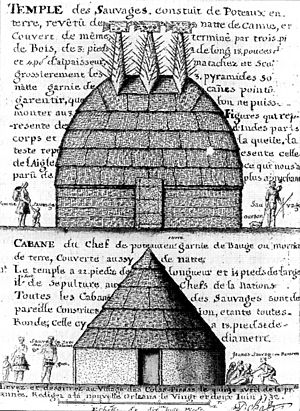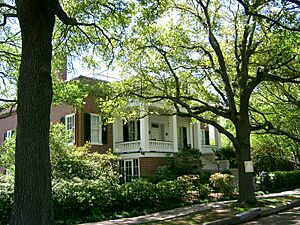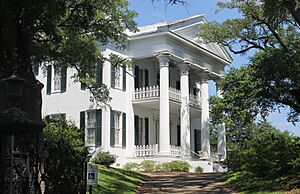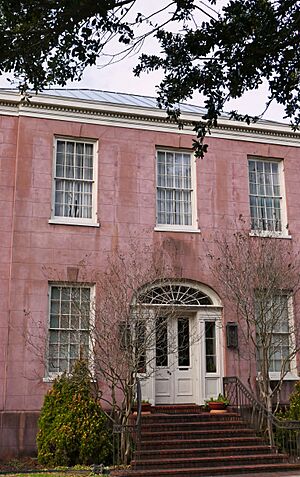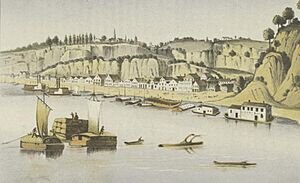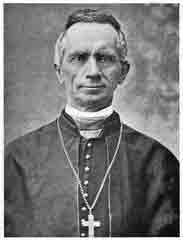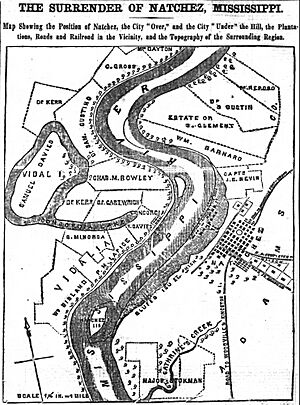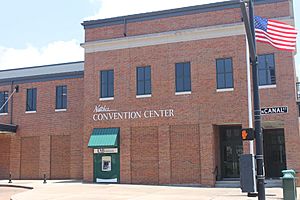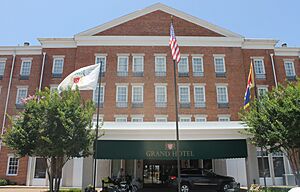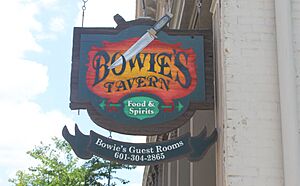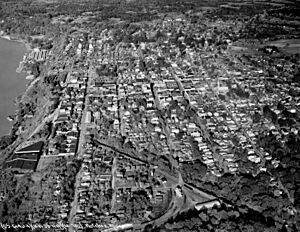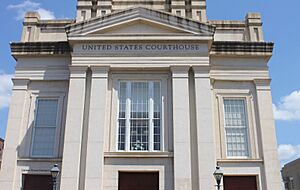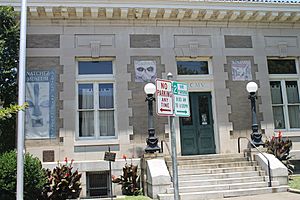History of Natchez, Mississippi facts for kids
The city of Natchez, Mississippi, was founded in 1716 as Fort Rosalie. It was later renamed in 1763 for the Natchez people, who were the original inhabitants of the area.
Contents
Early History: Before Europeans Arrived (to 1716)
Digs by archaeologists show that people have lived in the Natchez area since the 700s AD. The first Natchez settlement was a large village with special platform mounds. These mounds were built by the ancient Plaquemine culture, who were part of the important Mississippian culture. They started building the three main earth mounds around 1200. More work was done on them in the mid-1400s.
By the late 1600s and early 1700s, the Natchez (pronounced "Nochi") lived at this site. They were descendants of the Plaquemine culture. They used this place as their main ceremonial center after leaving the Emerald Mound area. They added to the mounds, building a home for their chief, the "Great Sun," on Mound B. They also built a temple and a special house for important leaders on Mound C.
Many early European explorers visited the Natchez at this site, which they called the Grand Village of the Natchez. These explorers included Hernando de Soto, La Salle, and Bienville. Their writings describe the Natchez society and village.
The most detailed story came from French colonist Antoine-Simon Le Page du Pratz. He lived near the Natchez for several years, learning their language and making friends with their leaders. He saw the funeral of the war chief, Tattooed Serpent, in 1725. The Natchez had a society with different ranks, divided into nobles and commoners. Family lines were traced through mothers. The main chief, called the "Great Sun," got his position because of his mother's rank. His next oldest brother served as Tattooed Serpent.
The Grand Village of the Natchez is now a protected National Historic Landmark. It is managed by the Mississippi Department of Archives and History. The site has a museum with artifacts found from the mounds and village. There are also picnic areas and walking trails. Nearby Emerald Mound is another important historic site for the Natchez people and their ancestors.
Colonial Times (1716–1783)
In 1716, the French built Fort Rosalie to protect a trading post they had set up two years earlier. This was in the Natchez territory. French settlements and farms then grew too close to the fort and to important Native American areas. The French settlers often fought with the Natchez people over land and resources. The Natchez people started to split into groups that favored either the French or the English. Those living further away had more contact with English traders from the British colonies to the east.
After several smaller conflicts, the Natchez, along with the Chickasaw and Yazoo tribes, started a war against the French in November 1729. Europeans called it the "Natchez War" or Natchez Rebellion. The Native Americans destroyed the French colony at Natchez and other nearby settlements. On November 29, 1729, the Natchez killed 229 French colonists. They took most of the women and children as captives. The French and their Native American allies attacked the Natchez many times over the next two years. Most of the Natchez people were killed, enslaved, or forced to flee as refugees.
After the Natchez leader and several hundred people surrendered in 1731, the French took them to New Orleans. They were then sold as slaves and sent to work on sugar plantations in Saint-Domingue. This was ordered by the French prime minister, Maurepas. Many Natchez who escaped slavery found safety with the Creek and Cherokee peoples. They eventually became part of those tribes. Today, descendants of the Natchez people have reorganized as the Natchez Nation. They are a treaty tribe and part of the federally recognized Muscogee (Creek) Nation.
After the Seven Years' War, in 1763, Fort Rosalie and the town around it came under British rule. The town was renamed Natchez. The British King gave land in this area to officers who had fought well in the war. These officers mostly came from New York, New Jersey, and Pennsylvania. They started farms and brought their wealthy way of life to the area.
In 1779, the Spanish commander, Juan de la Villebreuvre, took Fort Bute, and later the forts at Baton Rouge and Natchez's Fort Panmure. This established Spanish colonial rule. However, a group of Natchez loyal to the British forced him to surrender Fort Panmure in May 1781. A few days later, the British lost Pensacola, and the Natchez revolt ended. After losing the American Revolutionary War, Great Britain gave the territory to the United States in the Treaty of Paris (1783). Spain was not part of this treaty, and their forces had taken Natchez from the British. Spain had been allied with the American colonists, but they wanted to gain power from Britain. After the war, they did not want to give up what they had won.
In 1797, Major Andrew Ellicott of the United States Army marched to the highest point in Natchez. He set up camp and raised the first American Flag. This claimed Natchez and all former Spanish lands east of the Mississippi River above the 31st parallel for the United States.
A count of people in the Natchez District in 1784 showed 1,619 people. This included 498 black slaves.
Before the Civil War (1783–1860)
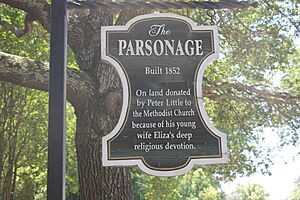
In the late 1700s, Natchez was the start of the Natchez Trace overland route. This was a Native American trail that followed paths made by migrating animals. It ran from Natchez to Nashville, through what are now Mississippi, Alabama, and Tennessee. Farmers used flatboats and keelboats to transport their crops and goods on the Mississippi River. They usually sold their goods and even their boats in Natchez or New Orleans. Then, they walked the long way back home on the Natchez Trace. These boatmen were often called "Kaintucks" because many were from Kentucky. The Trace was used a lot until steamboats were invented in the 1820s. Steamboats allowed travel upriver against the current.
On October 27, 1795, the U.S. and Spain signed the Treaty of San Lorenzo. This settled their border dispute. Spain officially gave up its claims to Natchez to the United States. It took more than two years for the Spanish army there to get the official orders. In early 1797, the U.S. government sent supplies to Natchez. Spanish officials had strict rules for trade and town development. But they gave up the fort and the town of Natchez to U.S. forces on March 30, 1798.
A week later, Natchez became the first capital of the new Mississippi Territory. On March 10, 1803, the town was officially made a city. After serving as the capital for several years, the territory built a new capital called Washington, about 6 miles east. After about 15 years, the capital moved back to Natchez in late 1817, when Mississippi became a state. Later, the capital returned to Washington. As more settlers moved north and east, the state decided to move the capital to the more central city of Jackson in 1822.
By 1830, Natchez had a population of 2,789 people. The harbor master reported that 383 steamboats, 10 keelboats, and 868 flatboats visited in 1829. Like other river towns, Natchez was a place where gamblers often visited.
Throughout the early 1800s, Natchez was the main center of business for the young state. Its location on high bluffs by the Mississippi River helped it become a busy port. In Natchez, many local farm owners loaded their cotton onto steamboats at a spot called Natchez Under-the-Hill. The cotton was sent downriver to New Orleans or sometimes upriver to St. Louis or Cincinnati. The cotton was sold and shipped to factories in New England, New York, and Europe.
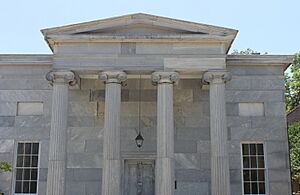
The Natchez District was one of the first places in the United States to grow cotton. Before new types of cotton were created in the early 1800s, it was not profitable to grow cotton anywhere else in the U.S. The Natchez District was important for trying out new types of cotton. Historians say that Eli Whitney's invention of the cotton gin helped the cotton industry grow a lot. The cotton gin made it cheaper to process short-staple cotton. This made it profitable to grow cotton in the uplands and throughout the Black Belt of the Deep South. As cotton farms grew quickly, the demand for slaves in the South increased. Slaves were sold in the domestic slave trade, mainly from the Upper South.
The growth of the cotton industry brought many new white settlers to Mississippi. They competed with the Choctaw people for their land. Even after the Choctaw gave up some land, settlers kept moving onto their territory, leading to conflict. When President Andrew Jackson was elected in 1828, he pushed for Indian removal. Congress passed a law allowing this in 1830. Starting with the Choctaw, the government began moving Southeastern Native Americans in 1831 to lands west of the Mississippi River. Nearly 15,000 Choctaw left their homeland over the next two years.
The land around Natchez on the Mississippi side of the river is hilly. The city sits on a high bluff above the Mississippi River. To reach the riverbank, you have to go down a steep road to a landing called Silver Street. This is very different from the flat "delta" land across the river near Vidalia, Louisiana. Wealthy farm owners built many beautiful mansions and estates here before the Civil War. Many owned farms in Louisiana but chose to live on the higher ground in Mississippi. Before the Civil War, Natchez had more millionaires than almost any other city in the United States. Famous people like Aaron Burr, Henry Clay, Andrew Jackson, and Ulysses S. Grant visited Natchez. Today, the city says it has more pre-Civil War homes than any other U.S. city. This is because Natchez was not destroyed like many other Southern cities during the Civil War.
The Forks of the Road Market had the most slave sales in Natchez. Natchez had the busiest slave trading market in Mississippi. This also made the city very wealthy. The market became especially important after slave traders Isaac Franklin and John Armfield bought the land in 1823. Tens of thousands of slaves passed through this market. They were brought from Virginia and the Upper South, many walking overland. They were sent to farms in the Deep South. In this forced migration, over one million enslaved Black Americans were taken from their families and moved south. All trading at the market stopped by the summer of 1863, when Union troops took control of Natchez.
Before 1845, only the city's wealthy families could afford a formal education for their children. Even though many parents did not have much schooling, they wanted their children to get a good education. Schools opened in the city as early as 1801. But many rich families still used private tutors or sent their children to schools outside the state, some even to England and Scotland. The city founded the Natchez Institute to offer free education to other white residents. Children from different economic backgrounds could get an education there. However, class differences still existed among students, especially in school choice and social connections. Even though it was against the law, black slave children were often taught the alphabet and how to read the Bible by their white playmates in private homes.
Natchez also had a unique history with many free people of color during slavery. Records from 1850 and 1860 show that about 85% of free people of color were mixed-race. They were often the children of white male farm owners and enslaved or freed black women. Mixed-race free people of color in Natchez gained wealth in several ways. Often, their white fathers gave them inheritances or their half-family members helped them start businesses. Some important free people of color in Natchez included William Johnson, Robert W. Fitzhugh, William McCary, and Louis Winston. Robert H. Wood was another important free person of color. He became the mayor of Natchez, the same job his white father, Robert Wood, had years earlier.
It was once thought that free people of color had few rights, no matter their wealth. But recent research shows this was not true for wealthy free people of color. Being wealthy and accepted by the richest white families gave these few people a rare amount of respect and power. William Johnson, a well-known free person of color, tried to be recognized as a farm owner by Natchez society. Archie P Williams, a free person of color from Natchez, was recognized as a farm owner. He was the son of David Percy Williams of Natchez and inherited much of his wealth. Archie P Williams's white family line had been one of the wealthiest in the region for generations. Archie P Williams was one of the few millionaires (especially mixed-race or black millionaires) in the 1800s. This was due to his inherited share of the multi-million dollar estate of Winthrop Sargent, who was his grandfather's stepfather. Other free people of color in Natchez became skilled workers like artisans, mechanics, and shoemakers. They lived a comfortable life, unlike enslaved African Americans. Some descendants of free people of color from that time still live well in the Natchez, Mississippi region.
The American Civil War (1861–1865)
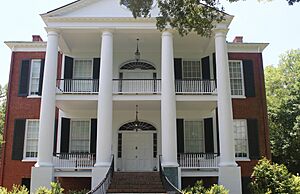
During the Civil War, Natchez was mostly undamaged. The city surrendered to Flag-Officer David G. Farragut after New Orleans fell in May 1862. Two civilians, an elderly man and an eight-year-old girl named Rosalie Beekman, were killed when a Union ironclad ship fired on the town from the river. The man died of a heart attack, and Rosalie was killed by a shell piece. Union troops led by Ulysses S. Grant took over Natchez in 1863. Grant set up his temporary headquarters in the Natchez mansion Rosalie.
Some Natchez residents still opposed the Federal authorities. In 1864, William Henry Elder, the Catholic bishop of the Diocese of Natchez, refused a Federal order. The order told him to make his church members pray for the President of the United States. U.S. officials arrested Elder, put him in jail briefly, and sent him across the river to Confederate-held Vidalia. Elder was eventually allowed to return to Natchez and continue his church duties. He served until 1880, when he became Archbishop of Cincinnati.
In 1860, not all farm owners in the Natchez region were strong supporters of the Confederacy. Some were new to the South, opposed secession, or had business ties to the North. These planters did not have a strong emotional connection to the South. But when the war came, many of their sons and nephews joined the Confederate army anyway. Charles Dahlgren was one of the new arrivals; he was from Philadelphia and had made his money before the war. He did support the Confederacy and led a brigade. But he was criticized for not defending the Gulf Coast. When the Union soldiers came, he moved to Georgia for the rest of the war. He returned in 1865 but never got his wealth back. He had to declare bankruptcy, and in 1870, he moved to New York City.
After the Union victory at the Battle of Vicksburg in July 1863, many refugees, including former slaves freed by the Emancipation Proclamation, moved into Natchez. Union Army officers said they did not have enough resources to help the refugees. The Army planned to help by paying freed slaves to work on government-leased farms. They also planned to enlist able-bodied men into the Union Army and set up refugee camps where former slaves could get an education. However, as the war continued, the plan was not fully put into action. The leased farms were poorly managed and often attacked by Confederate troops. Hundreds of people living in Natchez during this time, including many former slaves and refugees, died from hunger, disease, or fighting.
During the war, Natchez was nicknamed "Tradyville" by both sides. This was because it was known for its illegal trade.
White Natchez residents became much more supportive of the Confederacy after the war. The Lost Cause idea developed as a way for the South to deal with its defeat. It quickly became a strong belief, supported by celebrations, speeches, clubs, and statues. The main groups that worked to create and keep this tradition were the United Daughters of the Confederacy and United Confederate Veterans. In Natchez and other cities, local newspapers and war veterans helped keep the Lost Cause alive. But wealthy white women were especially important. They helped set up cemeteries and memorials, like the Civil War monument dedicated on Memorial Day 1890. The Lost Cause allowed (white) civilians to feel connected to this major event that reshaped Southern history.
After the War (1865–1900)

Natchez quickly recovered economically after the war. Much of the commercial shipping on the Mississippi River started again. Cotton was still the main crop. But the gang labor of enslaved people was mostly replaced by sharecropping. In sharecropping, freed people felt they had some independence. In many families, women stopped working in the fields to care for their own families. During tough times, they might work for their family and later had to take jobs as domestic servants.
Besides cotton, new local industries like logging added to the goods shipped from the city's wharf. In return, Natchez received many manufactured goods from northern markets like Cincinnati, Pittsburgh, and St. Louis.
The city's important role in Mississippi River trade during the 1800s was shown by nine steamboats being named Natchez. These ships traveled the lower river between 1823 and 1918. Many were built for and commanded by Captain Thomas P. Leathers. In 1885, the Anchor Line, known for its fancy steamboats, launched its "brag boat," the City of Natchez. This ship operated for a year before it was lost in a fire in Cairo, Illinois, on December 28, 1886. Since 1975, a tour steamboat in New Orleans has been named Natchez.
This river trade helped the city's economy grow until just after 1900. Then, railroads started to replace steamboat traffic. The city's economy declined throughout the 1900s, like many Mississippi River towns that railroads bypassed. Tourism has helped make up for this decline.
After the war and during Reconstruction, the lives of domestic servants in Natchez changed because of emancipation and freedom. After the Civil War, most domestic servants continued to be black women. Often, these women were supporting children. Even though they were paid little, their domestic work brought important income for their families. White employers often continued the old ways of treating workers, similar to how slaveholders treated slaves. They often preferred black workers over white servants. White men and women who worked as domestics usually had jobs like gardener or governess. Black servants worked as cooks, maids, and laundresses.
In 1871, Natchez opened its first public school (Kindergarten to 12th grade) for African American students, called the Union School.
Natchez Since 1900
For a short time, Stanton College in Natchez educated daughters of the white elite. It was located in Stanton Hall, which was built as a private mansion in 1858. In the early 1900s, the college was a place where daughters of old wealthy families met those from new business families. There were also interactions between traditional parents and their more modern daughters. The young women joined social clubs and literary groups. This helped them keep connections with cousins and family friends. The classes included lessons on proper behavior and letter writing. They also learned skills that could help those facing financial hardship make a living. The girls often disliked the dress codes and rules, but they also copied their parents' social values. Stanton Hall was named a National Historic Landmark in the late 1900s.
Located on the Mississippi River, the town had a lively nightlife for a long time. It featured jazz and blues music played by Black American musicians. On April 23, 1940, 209 people died in a fire at the Rhythm Night Club, a black dance hall in Natchez. The local newspaper said that "203 black bought 50 cent tickets to eternity." This fire is known as the fourth-deadliest fire in U.S. history. Several blues songs remember this tragedy and mention Natchez.
Industrial companies came to Natchez in the 1960s, bringing important jobs to the city. One of them was Armstrong Tire and Rubber company. These companies often continued the pattern of segregation. They kept African Americans in lower-level jobs. The National Association for the Advancement of Colored People (NAACP) encouraged them to end these restrictions.
Civil Rights Era
In the early 1960s, as the civil rights movement gained success, Natchez became a center of Ku Klux Klan activity. The Klan opposed integration and the movement. E. L. McDaniel, the Grand Dragon of the United Klans of America, had his office in Natchez. In August 1964, McDaniel started a Klan group in Natchez, using the name Adams County Civic and Betterment Association as a cover.
Despite the violence, Forrest A. Johnson, Sr., a respected white lawyer in Natchez, started speaking and writing against the Klan. From 1964 to 1965, he published a newspaper called the Miss-Lou Observer. In it, he weekly challenged the Klan. Klan members and their supporters boycotted his law practice, almost ruining him financially.
As Klan violence increased in the 1960s, African Americans formed an armed group called the Deacons for Defense and Justice. They copied a group from Louisiana. James Jackson, a Natchez barber, announced the group's formation the day after George Metcalf was badly hurt in a car bombing on August 27, 1965. The Deacons began to go with NAACP officers and protesters. They openly carried weapons, which was allowed under Mississippi law.
In 1966, the House Un-American Activities Committee published the names of Natchez residents who were Klan members. This included over 70 employees at the International Paper plant in the city, as well as members of the Natchez police and sheriff's departments. The committee found that at least four white supremacist groups were active in Natchez during the 1960s. One was the Mississippi White Caps. This group secretly handed out flyers around the city, threatening "crooks and mongrelizers." The Americans for the Preservation of the White Race was founded in May 1963 by nine Natchez residents.
By 1966, the Voting Rights Act had been passed. But courts used other ways to keep black people from serving on juries, even though many were registering to vote.
Natural Disasters
On May 7, 1840, a powerful tornado hit Natchez. It killed 269 people, most of whom were on flatboats in the Mississippi River. The tornado killed 317 people in total, making it the second-deadliest tornado in United States history.
In August 2005, after Hurricane Katrina, Natchez became a safe place for people from coastal Mississippi and Louisiana. It provided shelters, hotel rooms, rentals, and animal shelters. Natchez was able to keep fuel supplies open, provide power to affected areas, receive food, and maintain order while helping visitors. Many churches, including Parkway Baptist Church, were used as emergency shelters. In the months after the hurricane, most available homes were bought or rented. Some people even made Natchez their permanent home.
Flooding in 2011 caused the Mississippi River to reach 61.9 feet on May 19. This was the highest recorded height of the river since the 1930s.
Images for kids
Wealthy families in Natchez have used the Natchez Pilgrimage. This is an annual tour of the old mansions. It shows a nostalgic view of the city's pre-Civil War society, which included slaveholding. However, since the Civil Rights Movement, this version has been increasingly challenged by black people. They have worked to add the black experience in Natchez to its public history. According to author Paul Hendrickson, "Blacks are not a part of the Natchez Pilgrimage."
By the winter of 1988, the National Park Service created Natchez National Historical Park around Melrose mansion. The William Johnson House in the city was added a few years later. The tours given by the National Park Service try to show a more complete view of the past. They include African-American history. In 2021, Forks of the Road Market was added to the National Historical Park. This market was once the second largest slave-trading site in the United States.
The historic district has been used by Hollywood as a setting for movies about the pre-Civil War period. Disney's The Adventures of Huck Finn was partly filmed here in 1993. The 1982 television movie Rascals and Robbers: The Adventures of Tom Sawyer and Huck Finn was also filmed here. The TV mini-series Beulah Land was filmed in Natchez. Also, parts of the TV mini-series North and South were filmed in Natchez and nearby Washington. John Wayne's The Horse Soldiers was filmed in and around Natchez.
In 2007, a United States Courthouse opened after an old hall was renovated for new use. Part of the old hall had a Jim Crow-era monument to local men and women from Natchez and Adams County who served in World War I. The 1924 monument was discussed in the Natchez Democrat newspaper. Reporters noted it did not include black Army troops who had served in the war. A 2010 article suggested updating the monument to include all local troops and retiring the old one. On November 10, 2011, new plaques were put up. They include the names of 592 African-American soldiers and 107 white soldiers, none of whom had been on the old plaques.
A film called Black Natchez (2010) by filmmaker Ed Pincus showed a true-to-life account of the 1960s Civil Rights Movement in Natchez. The film highlights how the black community organized in 1965–1967. A black leader was injured in a car bombing, and a struggle for control began within the black community. A group of black men formed a chapter of the Deacons for Defense. The community split between more conservative and activist groups.
A Museum of African American History and Culture has opened in Natchez.


